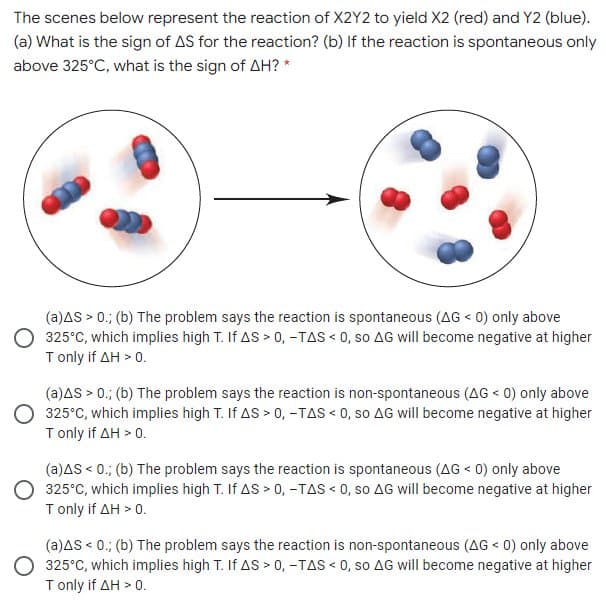The scenes below represent the reaction of X2Y2 to yield X2 (red) and Y2 (blue). (a) What is the sign of AS for the reaction? (b) If the reaction is spontaneous only above 325°C, what is the sign of AH? * (a)AS > 0.; (b) The problem says the reaction is spontaneous (AG < 0) only above 325°C, which implies high T. If AS > 0, -TAS < 0, so AG will become negative at higher T only if AH > 0. (a)AS > 0.; (b) The problem says the reaction is non-spontaneous (AG < 0) only above 325°C, which implies high T. If AS > 0, -TAS < 0, so AG will become negative at higher T only if AH > 0. (a)AS < 0.; (b) The problem says the reaction is spontaneous (AG < 0) only above O 325°C, which implies high T. If AS > 0, -TAS < 0, so AG will become negative at higher T only if AH > 0. (a)AS < 0.; (b) The problem says the reaction is non-spontaneous (AG < 0) only above O 325°C, which implies high T. If AS > 0, -TAS < 0, so AG will become negative at higher T only if AH > 0.
The scenes below represent the reaction of X2Y2 to yield X2 (red) and Y2 (blue). (a) What is the sign of AS for the reaction? (b) If the reaction is spontaneous only above 325°C, what is the sign of AH? * (a)AS > 0.; (b) The problem says the reaction is spontaneous (AG < 0) only above 325°C, which implies high T. If AS > 0, -TAS < 0, so AG will become negative at higher T only if AH > 0. (a)AS > 0.; (b) The problem says the reaction is non-spontaneous (AG < 0) only above 325°C, which implies high T. If AS > 0, -TAS < 0, so AG will become negative at higher T only if AH > 0. (a)AS < 0.; (b) The problem says the reaction is spontaneous (AG < 0) only above O 325°C, which implies high T. If AS > 0, -TAS < 0, so AG will become negative at higher T only if AH > 0. (a)AS < 0.; (b) The problem says the reaction is non-spontaneous (AG < 0) only above O 325°C, which implies high T. If AS > 0, -TAS < 0, so AG will become negative at higher T only if AH > 0.
Chapter17: Spontaneity, Entropy, And Free Energy
Section: Chapter Questions
Problem 7RQ: If you calculate a value for G for a reaction using the values of Gf in Appendix 4 and get a...
Related questions
Question

Transcribed Image Text:The scenes below represent the reaction of X2Y2 to yield X2 (red) and Y2 (blue).
(a) What is the sign of AS for the reaction? (b) If the reaction is spontaneous only
above 325°C, what is the sign of AH? *
(a)AS > 0.; (b) The problem says the reaction is spontaneous (AG < 0) only above
325°C, which implies high T. If AS > 0, -TAS < 0, so AG will become negative at higher
T only if AH > 0.
(a)AS > 0.; (b) The problem says the reaction is non-spontaneous (AG < 0) only above
325°C, which implies high T. If AS > 0, -TAS < 0, so AG will become negative at higher
T only if AH > 0.
(a)AS < 0.; (b) The problem says the reaction is spontaneous (AG < 0) only above
O 325°C, which implies high T. If AS > 0, -TAS < 0, so AG will become negative at higher
T only if AH > 0.
(a)AS < 0.; (b) The problem says the reaction is non-spontaneous (AG < 0) only above
O 325°C, which implies high T. If AS > 0, -TAS < 0, so AG will become negative at higher
T only if AH > 0.
Expert Solution
This question has been solved!
Explore an expertly crafted, step-by-step solution for a thorough understanding of key concepts.
Step by step
Solved in 2 steps with 1 images

Knowledge Booster
Learn more about
Need a deep-dive on the concept behind this application? Look no further. Learn more about this topic, chemistry and related others by exploring similar questions and additional content below.Recommended textbooks for you


Chemistry
Chemistry
ISBN:
9781305957404
Author:
Steven S. Zumdahl, Susan A. Zumdahl, Donald J. DeCoste
Publisher:
Cengage Learning

Chemistry: An Atoms First Approach
Chemistry
ISBN:
9781305079243
Author:
Steven S. Zumdahl, Susan A. Zumdahl
Publisher:
Cengage Learning


Chemistry
Chemistry
ISBN:
9781305957404
Author:
Steven S. Zumdahl, Susan A. Zumdahl, Donald J. DeCoste
Publisher:
Cengage Learning

Chemistry: An Atoms First Approach
Chemistry
ISBN:
9781305079243
Author:
Steven S. Zumdahl, Susan A. Zumdahl
Publisher:
Cengage Learning

Chemistry by OpenStax (2015-05-04)
Chemistry
ISBN:
9781938168390
Author:
Klaus Theopold, Richard H Langley, Paul Flowers, William R. Robinson, Mark Blaser
Publisher:
OpenStax

Chemistry: Principles and Practice
Chemistry
ISBN:
9780534420123
Author:
Daniel L. Reger, Scott R. Goode, David W. Ball, Edward Mercer
Publisher:
Cengage Learning

Chemistry: Principles and Reactions
Chemistry
ISBN:
9781305079373
Author:
William L. Masterton, Cecile N. Hurley
Publisher:
Cengage Learning